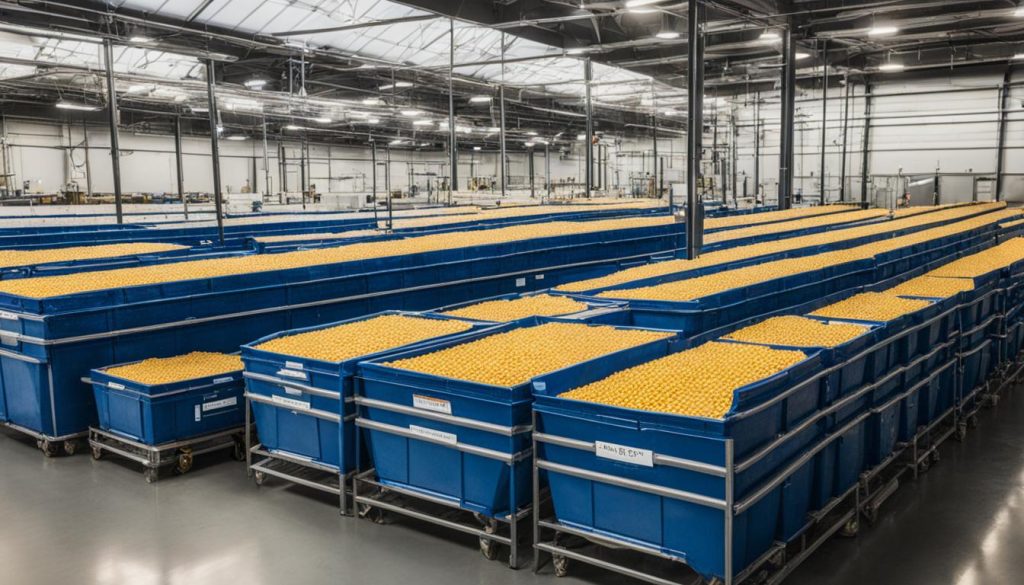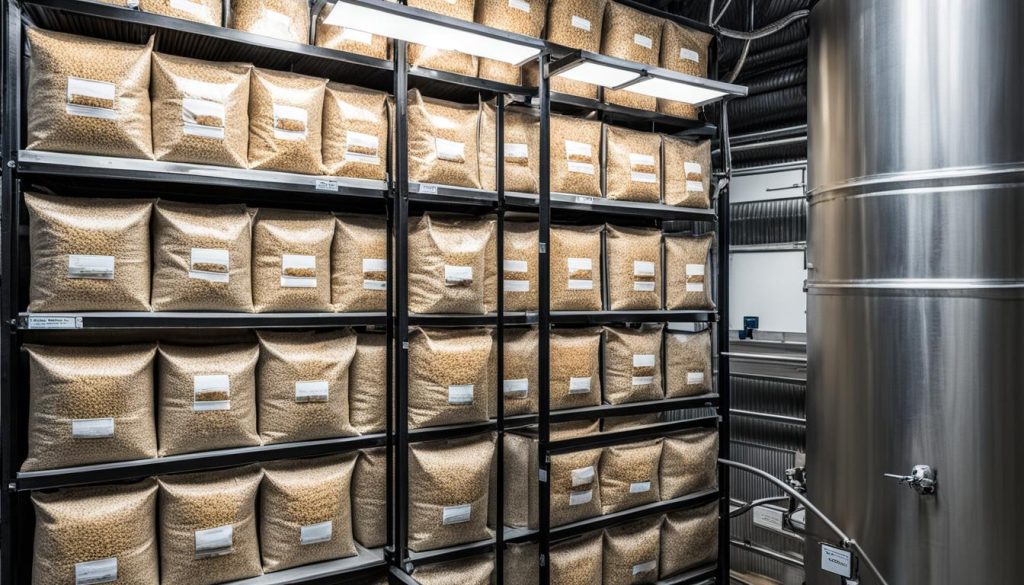Did you know that improper grain storage can result in a loss of up to 20% of a farmer’s crop?
Proper long-term grain storage is crucial for maintaining the quality and longevity of your grains. Factors such as moisture, temperature, and pests can affect grain quality, so it’s essential to use the right storage containers and techniques. By following these long-term grain storage solutions, you can ensure the longevity of your grains and prevent spoilage.
Key Takeaways:
- Implement moisture control and pest management practices to maintain grain quality.
- Choose appropriate storage facilities and containers for long-term grain storage.
- Prevent mycotoxin contamination by using proper storage techniques.
- Follow bulk storage tips for different grain types.
- Maintain proper temperature levels in storage bins to preserve grain quality.
Tips for Storing Grains Long Term
Proper storage is essential for maintaining the quality of grains during long-term storage. Factors such as grain quality and moisture control play a crucial role in preventing spoilage and ensuring the longevity of your stored grains. Here are some tips to help you store grains effectively:
- Check Grain Quality: Before storing grains, inspect them for any cracked or damaged grains. Removing these grains will prevent them from affecting the overall quality of your stock.
- Ensure Proper Drying: Moisture is a common cause of grain spoilage. To avoid mold growth, ensure that the grains are properly dried before storage.
- Use Bulk Grain Bags: Consider using bulk grain bags as storage containers. These bags are specifically designed to protect against pests and help maintain the quality of the grains.
- Opt for Light-Proof Containers: Storing grains in dark, light-proof containers can reduce the risk of mold growth. Exposure to light can activate certain enzymes in grains, leading to deterioration.
- Regularly Monitor Grain Quality: Monitoring the moisture level and overall quality of your stored grains is crucial. Regular inspections will allow you to identify any issues early on and take necessary measures to prevent spoilage.
By following these tips, you can ensure that your grains remain in excellent condition for long-term storage. Remember to prioritize grain quality and moisture control to preserve the integrity of your stock.
| Tip | Description |
|---|---|
| Check Grain Quality | Inspect grains for cracks or damage before storage. |
| Ensure Proper Drying | Properly dry grains to prevent mold growth. |
| Use Bulk Grain Bags | Opt for bulk grain bags for effective storage. |
| Opt for Light-Proof Containers | Store grains in dark, light-proof containers to minimize the risk of mold growth. |
| Regularly Monitor Grain Quality | Monitor moisture levels and overall grain quality to prevent spoilage. |
Long-Term Storage Guide for Corn
When it comes to long-term grain storage, corn is an incredibly popular option due to its versatility and widespread use. However, to ensure the long shelf life of corn, it is essential to follow proper storage practices and techniques.
One crucial step in long-term corn storage is to ensure that the corn has been properly dried before storage. Excessive moisture can lead to mold growth and spoilage. It is recommended to dry the corn to a moisture level of 12-14% before storing it.
Another factor to consider is the type of corn being stored. Different corn varieties have varying storage capabilities. Hard corn varieties, such as dent corn or flint corn, tend to have a longer storage life compared to soft corn varieties like sweet corn.
Proper storage containers also play a significant role in maintaining the quality of stored corn. It is recommended to store corn in airtight containers like food-grade buckets or specialized grain storage bins to prevent exposure to moisture and pests.
Maintaining the correct moisture level is crucial for preserving corn quality during long-term storage. Moisture levels that are too high can lead to mold growth, while moisture levels that are too low can cause shrinkage and loss of quality. Regular monitoring and adjustment of moisture levels are necessary to ensure optimal storage conditions.
Here are a few key points to remember for successful long-term corn storage:
- Properly dry corn to a moisture level of 12-14% before storing.
- Choose hard corn varieties for longer storage life.
- Store corn in airtight containers like food-grade buckets or specialized grain storage bins.
- Maintain the correct moisture level to prevent mold growth and shrinkage.
Following these guidelines will help ensure the long-term storage and preservation of corn, maintaining its quality and nutritional value for an extended period.
Long-Term Storage Guide for Wheat
When it comes to long-term grain storage, wheat is a staple that requires special attention. Proper storage techniques can help maintain the quality and longevity of your wheat, ensuring a stable supply for the future.
One important consideration is the form in which you store your wheat. Whole wheat kernels have a longer shelf life compared to ground flour. By keeping the grains intact, you can extend their storage capabilities and prevent premature spoilage.
To preserve the quality of your wheat, it’s crucial to use suitable storage containers. Opt for food-grade options such as mylar bags or food-grade buckets to ensure that the containers do not contaminate the grain. These containers provide a protective barrier against pests and help maintain the proper moisture level.
Moisture control is one of the key factors in long-term wheat storage. Excess moisture can accelerate spoilage and promote the growth of mold and fungi. Preventing moisture buildup is essential to preserving the quality of your wheat. Regularly check the moisture level using moisture meters or other suitable methods to ensure optimal conditions.
In addition to moisture control, temperature management plays a vital role in wheat storage. Keeping the temperature within the recommended range helps prevent the growth of pests and extends the shelf life of the grain. Maintain a cool, dry environment to minimize the risk of temperature fluctuations.
To ensure successful long-term wheat storage, it’s essential to regularly monitor the grain quality. Check for signs of pests, mold, or other indicators of spoilage. Implement a system for routine inspections to catch any potential issues early and address them promptly.
For more detailed information on long-term wheat storage, you can refer to this resource. It provides valuable insights and practical tips to help you optimize your wheat storage techniques.
How to Store Grains Properly for Long-Term Storage
Proper grain storage techniques are essential for ensuring the long-term preservation and quality of your grains. Implementing effective storage practices will help prevent spoilage and maintain the nutritional value of your crops. Here are some key considerations for storing grains:
1. Choose the Right Storage Containers
When selecting storage containers, opt for airtight options such as food-grade buckets or mylar bags. These containers provide a barrier against pests and moisture, protecting your grains from damage. Make sure to seal the containers tightly to maintain their integrity over time.
2. Control Moisture Levels
Moisture is a primary factor contributing to grain spoilage. Before storing your grains, ensure they are properly dried to reduce their moisture content. Moisture control is crucial for preventing the growth of mold, bacteria, and fungi. Regularly monitor the moisture levels inside the storage containers using appropriate tools such as moisture meters.
3. Monitor Temperature
Maintaining the right temperature is vital for preserving the quality of stored grains. Extreme temperature fluctuations can lead to condensation and spoilage. Store grains in a cool and dry environment, avoiding exposure to direct sunlight or heat sources. Use temperature monitoring devices to ensure the storage area remains within the recommended temperature range.
4. Inspect and Monitor Regularly
Regular inspections are crucial for identifying any signs of spoilage or pest infestation. Examine the grains periodically for mold, pests, or unusual odors. Implement a monitoring system to track the condition of your stored grains, including regular checks of moisture levels and temperature. This proactive approach will help you detect and address any issues before they escalate.
5. Store in a Clean Environment
Ensure your storage area is clean and free from debris. Cleanliness helps prevent contamination and undesired moisture accumulation. Keep pests at bay by regularly cleaning the storage containers and the surrounding space.
“Proper long-term grain storage is essential for maintaining grain quality and preventing spoilage.”
By following these proper storage techniques, you can safeguard the longevity and nutritional value of your grains. Implementing effective moisture control, temperature monitoring, and regular inspections will help maintain the quality of your stored grains, ensuring a stable and reliable food supply for the long term. For more information on grain storage best practices, visit this resource.
Conclusion
In conclusion, proper long-term grain storage is essential for maintaining the quality and longevity of your grains. By utilizing storage techniques such as moisture control and temperature monitoring, you can safeguard your grain investment and ensure a stable supply for the future. It is crucial to pay close attention to grain quality and regularly monitor the condition of your stored grains to prevent spoilage.
By following proper storage techniques and using appropriate storage containers, such as airtight food-grade buckets or mylar bags, you can protect your grains from pests and moisture damage. Remember to regularly inspect and maintain your storage facilities to ensure optimal conditions for long-term grain storage.
Whether storing corn, wheat, or other grain types, the principles of long-term storage remain the same. Take the necessary steps to properly dry your grains, select the right storage containers, and maintain optimal moisture levels. By doing so, you can extend the shelf life of your grains and preserve their quality over time.
With careful attention to grain quality, moisture control, and temperature management, you can establish a successful long-term grain storage system. Protect your grain investment and ensure a consistent supply by implementing these storage techniques and maintaining regular monitoring and maintenance practices.


